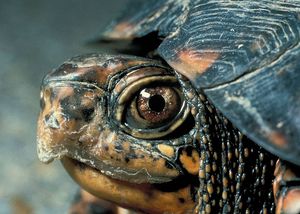Hypovitaminosis A, a vitamin A deficiency common in captive box turtles, endangers healthy hibernation patterns. Since turtles eat a frequently unbalanced diet, it is up to the pet owner to supervise the nutritional intake. Would you know what to look for?
Does My Box Turtle Suffer from Hypovitaminosis A?
Swollen eyelids are a telltale sign of this vitamin A deficiency. Veterinarian Greg Lewbart enumerates secondary symptoms of the condition, some of which include respiratory distress and also an easily visible nasal discharge.
At issue is an alarming decrease in the production of mucus. Although it is tempting to simply increase the vitamin A that turtles eat via supplementation, there is the risk of tipping the balance too far to the other side, which results in hypervitaminosis A.
Altering the Way Turtles Eat
Rather than going the chemical route, the pet owner is wise to change the way the box turtle eats. The Veterinary Services Department of Drs. Foster & Smith outlines the foods that are rich in vitamin A and suitable for a box turtle diet. Examples include peaches, sweet potatoes, spinach, kale, carrots and untreated dandelion greens.
Since box turtles can be finicky eaters, it is a good idea to cut down on foods that feature a very low amount of vitamin A but might fill up the animal to the point that it chooses to forgo the nutritionally richer other options. Examples of foods best limited include grapes, lettuce, bananas and apples.
Changing the Way Pet Owners Feed
While a dog will eventually give in to its growling stomach and eat whatever is placed in front of it, a box turtle will simply choose to sit out the undesirable meal offering and retreat into its shell. The Box Turtle Site refers to this behavior as a “hunger strike” and anyone who has ever attempted to coax a turtle to eat healthier is sure to understand the aptness of the description.
It is unfortunate that a good many box turtles have gotten accustomed to unhealthy foods that are devoid of sufficient vitamin A – in part – because pet owners were looking for convenient options to quickly feed the animals. Crumbling a head of iceberg lettuce into the terrarium on the way out is just one example of thoughtless feeding.
To counteract hypovitaminosis A via an alteration in the way your turtles eat, it may become necessary to take drastic measures, such as chop up some earthworms and serve them over shredded kale and diced liver. Yum!
As a general rule of thumb, feed the box turtle a diet that is made up (at least halfway) of high-protein food items; the other 50 percent should be a mix of fruits and veggies. Soaked cat chow is a common choice for pet lovers, but keep in mind that in addition to the vitamin fortification it frequently also has a lot of fat. Make sure that the animal does not gain too much weight!
Sources
Atlantic Coast Veterinary Conference: “Turtle (Chelonian) Medicine”
Drs. Foster & Smith: “Vitamin A Deficiency: Signs, Diagnosis, Treatment, and Prevention in Turtles”
Box Turtle Site: “Diet and Feeding Your Box Turtle”





